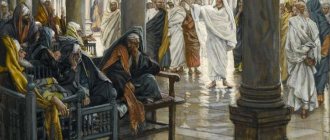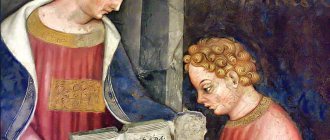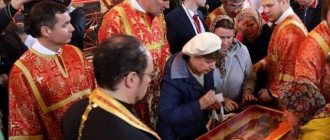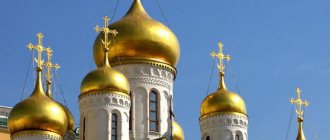How to write a life?
The vowel “e” should be written in the last syllable. The stress falls on the same syllable. Life is an outdated version of the word “life”. A hagiography is also a narrative about the life of a person who has been canonized as a saint.
Interesting materials:
What are bone conduction headphones? What is net in cooking? What are non-renewable energy resources? What is filament in an aquarium? What is nok 5th grade? What are normal conditions in chemistry? What is a World Natural and Cultural Heritage Site? What is offended? What is an image in literature briefly? What are custom and examples?
LIFE
LIFE (Greek βίος, Lat. vita), genre of church literature, biography of a saint. The field of literature to which the entire body of literature belongs is called “hagiography.” It is customary to divide paintings into groups according to the following criteria: the rank of holiness (hagiological type) of the person depicted; features of the narrative form; the lengthy or brief nature of the description of the life of a saint. In accordance with the ranks of holiness, works of martyrdom are divided into martyrdoms, lives of saints equal to the apostles, venerable lives (Lives of saints-monks), Lives of holy wives, Lives of holy fools (known only in Orthodox hagiography), saintly (Lives of saints - hierarchs of the Church), as well as lay saints; Among the latter, the journals of holy rulers are distinguished (in the Slavic tradition, the journals of holy princes). This classification is not strict, since a saint can simultaneously belong to several hagiological types (a martyr or missionary can simultaneously be a reverend, a holy wife can be a martyr and/or a nun, etc.). It narrates according to its features. forms are distinguished by J.-hagiobiography, which describes in detail the life of the saint from birth to death, and martyria (from the Greek μαρτύριον - torment; in Western Catholic traditions it was called passio), describing the martyr. the death of saints for their profession of faith, but not containing narratives of their lives in general. By nature, descriptions of the life of Saint J. can be lengthy or brief. Lengthy Zh. were intended for reading in monasteries at meals on the day of remembrance of the saint, for cell and home reading (in the Orthodox Greek and Slavic traditions they are usually called menain, because they were included in the Chetii-Minea). Brief journals were compiled for reading at divine services (in the Greek Orthodox tradition they were part of the collections Synaxarion and Menologies; in Ancient Rus' - in the collection “Prologue” created on the basis of the Synaxarion, which among the Orthodox South Slavs continued to be called the Synaxarion) .
From the point of view of the authority and reliability of the information reported by J., some saints in the church tradition are usually divided into canonical and apocryphal; The canonical and apocryphal works of the great martyrs George, Nicetas of Gotha, and Theodore Tiron are known. Journeys were often created by witnesses to the lives of saints or from eyewitness accounts. The purpose of J. is to preserve the memory of the saints, to edify the readers, and to glorify the saint at divine services. Services to saints were usually compiled based on J.'s materials. The writing of the book was often timed to coincide with the canonization of saints or served as preparation for canonization.
In contrast to secular biography, J. describes in the personality of the saint, first of all, the manifestation of the Divine principle; images of saints in paintings are usually not individualized; J. - “verbal icon” of the saint (V. O. Klyuchevsky). Zh. is characterized by a set of compositions. and stylistic “common places” (topos): the author’s prayer to God asking for help and recognition of his sinfulness and “unlearnedness”; information about the saint’s parents; the miracles accompanying his birth; baptism, naming of a name endowed with symbolic meaning and foreshadowing the exploits of the saint; his refusal in childhood to play with peers; turning to God; entering a monastery; demonic temptations; knowledge of the day of one's death and a pious death; intravital and posthumous miracles (healing of the blind, paralyzed, demon-possessed, etc.). Different types of life have their own set of topoi.
The formation of Zh. was partly influenced by various. traditions. It absorbed some features of ancient biography, ancient novel, folklore genres and mythological. ideas (for example, the motif of snake fighting in the life of the Great Martyr George).
The earliest women are martyrs. An initiative to compile the first collections of martyrs that have not reached us. J. is attributed to Rome. Popes Clement I and Fabian; later a martyrology was compiled, without sufficient grounds attributed to Jerome the Blessed; another collection written in English. Monk Beda the Venerable. In the 9th century in lat. In the West, the martyrologies were Flor, Hraban the Maurus, Vandelbert, Uzuard, in the 10th century. – Notker Stutterer. In Greek language the unsurvived martyrology of Eusebius of Caesarea was compiled, and his book on the Palestinian martyrs is also known. The History of the Persian Martyrs was compiled c. 410 ep. Targitsky Marufa.
The oldest reverend J. is the life of Anthony the Great, written by Athanasius the Great. In the 5th century In the East, Gerontius the Presbyter, Callinicus, and Theodoret of Cyrus wrote. Hagiographic tales about monks of a certain area were combined into special collections - patericons (Egyptian patericon - “Lavsaik” by Palladius, Sinai patericon - “Spiritual Meadow” by John Moschus).
To Byzantium. Hagiography coexisted two directions - “folk”, characterized by simplicity of language and commitment to everyday specifics, and “literary”, oriented towards book style, abstracted from the depiction of everyday realities, and tended towards parables. The “folk” direction includes the lives of John the Merciful and Simeon the Holy Fool, compiled by Leonty of Cyprus. In the 2nd half. 10th century in Byzantium, previously written stories were rewritten into abstract rhetoric. style by Simeon Metaphrastus (in total he edited 148 works, among them the lives of the Mother of God, Nicholas, Bishop of Myra, Dionysius the Areopagite).
First lat. J. – life of St. written by Deacon Pontius. Cyprian, Bishop of Carthage (mid 3rd century). Painted by Rufinus of Aquileia, John Cassian the Roman, Gregory of Tours and others. features are intensified in the works created by Valafrid Strabo (St. Blythemacca, St. Mamma). By the 11th century. in lat. bookishness finally developed canons for depicting the lives of saints; in the 12th century descriptions of miracles predominated in the journals. In the 11th–13th centuries. vaults of history—legendariums—were created. The most famous and widely read was the legendarium of the Dominican monk Jacob of Voraginsky, “The Golden Legend” (13th century), which included 180 pages; Sat. The “Catalog of Saints” was compiled in the 14th century. Peter Natalibus (d. 1382). Publication of the corpus of lat. Journal (“Acta Sanctorum”) was started in 1643 by the Bollandist Society (the publication continues to this day).
The most ancient Russian The stories date back to the turn of the 11th–12th centuries: “Reading about Boris and Gleb”; the life of Theodosius of Pechersk, compiled by Nestor, as well as “The Tale of Boris and Gleb” by an unknown author. Zh., compiled in the con. 14 – 1st quarter. 15th centuries Epiphanius the Wise (Sergius of Radonezh, Stephen, Bishop of Perm), written in a sophisticated style, which is characterized by a variety of rhetoric. techniques (style of “weaving words”). All R. 16th century the corpus of translated and original journals was collected by Metropolitan Macarius in the collection. "Great Chetyi-Minea". New edition of translated and original journals, also combined into a collection. Chetyikh-Minei, belongs to Metropolitan. Dimitri Rostovsky. Canonization by the Russian Church at the turn of the 20th–21st centuries. a large number of saints (primarily martyrs who suffered in the 20th century) became the reason for the active development of Russian. hagiography in the last 2 decades and the compilation of numerous. new journals, mostly based on documentary materials.
What is hagiography: definition of the genre and its features
Ancient written literature is divided into secular and ecclesiastical. The latter gained special distribution and development after Christianity began to occupy an increasingly strong position among other world religions.
Genres of religious literature
Ancient Rus' acquired its written language along with spiritual books that were brought from Byzantium by Greek priests. And the first Slavic alphabet, as you know, was developed by the Solun brothers, Cyril and Methodius.
Therefore, it was church texts that became the source of knowledge from which our ancestors comprehended book wisdom. The genres of ancient religious literature included psalms, lives, prayers and sermons, church legends, teachings and stories.
Some of them, for example the story, were subsequently transformed into the genres of secular works. Others remained strictly within church boundaries. Let's figure out what life is. The definition of the concept is as follows: these are works dedicated to describing the lives and deeds of saints.
We are not talking only about the apostles who continued the preaching work of Christ after his death. The heroes of hagiographic texts were martyrs who became famous for their highly moral behavior and suffered for their faith.
Characteristic features of hagiography as a genre
From this follows the first distinctive sign of what living is. The definition included some clarification: firstly, it was made about a real person.
The author of the work had to adhere to the framework of this biography, but pay attention precisely to those facts that would indicate the special holiness, chosenness and asceticism of the saint.
Secondly, what is a life (definition): this is a story compiled to glorify a saint for the edification of all believers and non-believers, so that they are inspired by a positive example.
An obligatory part of the narrative was messages about the miraculous power that God endowed with his most faithful servants. Thanks to God's mercy, they were able to heal, support the suffering, and perform the feat of humility and asceticism.
This is how the authors painted the image of an ideal person, but, as a result, many biographical information and details of private life were omitted. And finally, another distinctive feature of the genre: style and language.
There are many rhetorical exclamations, appeals, words and expressions with biblical symbolism.
Based on the above, what is living? The definition can be formulated as follows: it is an ancient genre of written literature (as opposed to oral folk art) on a religious theme, glorifying the deeds of Christian saints and martyrs.
Lives of the Saints
Hagiographies have long been the most popular in ancient Rus'. They were written according to strict canons and, in fact, revealed the meaning of human life. One of the most striking examples of the genre is “The Life of St. Sergius of Radonezh,” set forth by Epiphanius the Wise.
Here there is everything that should be in literary texts of this type: the hero comes from a pious family of righteous people, obedient to the will of the Lord. God's providence, faith and prayers support the hero from childhood. He meekly endures trials and trusts only in God's mercy.
The lives of Russian saints emphasized that their characters were not afraid of death, gradually prepared for it and accepted their departure with joy, as this allowed their souls to meet God and the angels. The work ended, as it began, with glorification and praise of the Lord, Christ and the Holy Spirit, as well as the righteous man himself - the venerable one.
List of hagiographic works of Russian literature
Peruvian Russian authors own about 156 texts related to the genre of hagiography. The first of them are associated with the names of princes Boris and Gleb, treacherously killed by their own brother. They also became the first Russian Christian martyrs-passion-bearers, canonized by the Orthodox Church and considered intercessors of the state.
Next, the lives of Prince Vladimir, Alexander Nevsky, Dmitry Donskoy and many other prominent representatives of the Russian land were created. A special place in this series is occupied by the biography of Archpriest Avvakum, the rebellious leader of the Old Believers, written by himself during his stay in the Pustozersky prison (17th century).
In fact, this is the first autobiography, the birth of a new literary genre.
Source: https://info-4all.ru/obrazovanie/samosovershenstvovanie/duhovnoe-razvitie/chto-takoe-zhitie-opredelenie-zhanra-i-ego-osobennosti/
Literature
- Life // Literary encyclopedia of terms and concepts / Ed. A. N. Nikolukina. - Institute of Scientific Information for Social Sciences of the Russian Academy of Sciences: Intelvac, 2001. - Stb. 267—280—1596 p. — ISBN 5-93264-026-Х.
- Barsov N.V.
Lives of the Saints // Encyclopedic Dictionary of Brockhaus and Efron: in 86 volumes (82 volumes and 4 additional). - St. Petersburg, 1890-1907. - Zubov V.P.
Epiphanius the Wise and Pachomius the Serb (on the issue of the editions of “The Life of Sergius of Radonezh”) // Proceedings of the Department of Old Russian Literature of the Institute of Russian Literature. M.; L., 1953. T. 9. P. 145-158. - Dmitriev L. A.
Hagiographic stories of the Russian North as literary monuments of the 13th—17th centuries: Evolution of the genre of legendary-biographical tales / Rep. ed. A. M. Panchenko; Institute of Russian Literature (Pushkin House) USSR Academy of Sciences. — L.: Science. Leningr. department, 1973. - 304 p. — 6850 copies. - Klyuchevsky V. O.
Old Russian lives of saints as a historical source. M., 2003. - Likhachev D.S.
Man in the literature of ancient Russia. M., 1970. - Ranovich A. B.
How the lives of the saints were created. - M.: Gospolitizdat, 1961. - 72 p. — (Popular science library on atheism). - Serebryansky N.
Old Russian princely lives. (Review of editions and texts). M., 1915. - Troitsky S.V.
// Orthodox Theological Encyclopedia. - St. Petersburg: Petrograd Publishing House. Supplement to the spiritual magazine “Wanderer”, 1904. - T. 5. - Stb. 582










